
Cashew Varieties
Akshaya (H-7-6)
.jpg)
Released in 1998 by the Cashew Research Station, Kerala Agricultural University (KAU), Anakkayam, Malappuram, this hybrid cashew variety (parentage: H-4-7 × K-30-1) is known for its compact canopy and intensive branching, making it ideal for high-density planting. It exhibits mid-season flowering (December–January) with fruiting from January to March. The variety produces yellow apples with a high juice content of 68%, and its nuts are of excellent export quality (W180 grade), weighing 11 grams each with a kernel weight of 3.12 grams and a shelling percentage of 28.36%. With an average yield of 11.78 kg of nuts per tree, it is a promising cultivar for commercial cultivation. Planting material is available at Cashew Research Stations of KAU at Madakkathara and Anakkayam
Amrutha (H-1597)
.jpg)
Released in 1998 by the Cashew Research Station, Kerala Agricultural University (KAU), Madakkathara, Amrutha (H-1597) is a high-yielding hybrid cashew variety developed from the cross BLA-139-1 × H-3-13. It features a spreading canopy and extensive branching, well-suited for mid-season flowering (December–January) and fruiting (January–March). The variety bears yellowish apples with a high juice content of 72.2%. Nuts are of export-grade quality (W210), weighing 7.18 grams with a kernel weight of 2.24 grams and a shelling percentage of 31.58%. With an impressive mean nut yield of 18.35 kg per tree, Amrutha is a commercially promising cultivar. Planting materials are available at the Cashew Research Station, KAU, Madakkathara – 680 651.
Anagha (H-8-1)
.jpg)
Anagha (H-8-1) is a compact and high-performing hybrid cashew variety released in 1998 by the Cashew Research Station, KAU, Anakkayam, Malappuram. Bred from the cross T20 × K-30-1, this variety is characterized by its compact canopy and intensive branching pattern, making it ideal for organized orchard management. It follows a mid-season cycle, flowering from January to February and fruiting from February to April. The variety produces attractive orange-red apples with a juice content of 66%. Nuts are of premium export quality (W180 grade), with an average weight of 10 g, kernel weight of 2.9 g, and a shelling percentage of 29%. With a mean nut yield of 13.73 kg per tree, Anagha stands out as a reliable choice for commercial cultivation. Planting material is available from both Cashew Research Stations of KAU at Madakkathara and Anakkayam.
Anakkayam -1(BLA-139-1)
.jpg)
This early maturing variety is known for its vigorous growth, compact canopy, and intensive branching, making it well-suited for systematic cultivation. It flowers during October to November and fruits from December to January, making it one of the earliest varieties under cultivation. The variety yields attractive pinkish-yellow apples with a high juice content of 71%. Nuts are classified under export grade W280, weighing 5.95 g with a kernel weight of 1.67 g and shelling percentage of 27.99%. The average yield per tree is 12 kg, and planting material is available at the Cashew Research Stations of KAU at Madakkathara and Anakkayam. Released in 1982 by the Cashew Research Station, KAU, Anakkayam, Malappuram, Anakkayam-1 (BLA-139-1) is a selection variety developed from Tree No. 139 of Bapatla, with a parentage of T20 × K-30-1.
Dhana (H-1598)
.jpg)
Developed at the Cashew Research Station, KAU, Madakkathara, and released in 1993, Dhana (H-1598) is a hybrid variety resulting from a cross between ALGD-1 and K-30-1. This variety is characterized by a compact canopy and intensive branching, ideal for high-density planting. It is a midseason, cluster-bearing type, flowering from December to January and fruiting from January to March. Dhana produces yellow apples with a high juice content of 72%. The nuts are of W210 export grade, weighing 8.2 g each, with a kernel weight of 2.44 g and a shelling percentage of 29.8%. The average nut yield per tree is 10.66 kg, making it a suitable variety for commercial cultivation. Planting material is available at the Cashew Research Stations of KAU at Madakkathara and Anakkayam.
Kanaka (H-1598)
.jpg)
Kanaka is a promising hybrid cashew variety released in 1993 by the Cashew Research Station, Kerala Agricultural University (KAU), Madakkathara. Originating from a cross between BLA-139-1 and H3-13, this variety is noted for its open canopy structure and intensive branching habit, supporting healthy growth and ease of management. It follows a mid-season flowering pattern, initiating blooms from November to December and producing fruits between December and March. The variety yields yellow apples rich in juice (70%) and produces nuts that fall under the W280 export grade, with an average nut weight of 6.8 g and a kernel weight of 2.08 g. The shelling percentage is 30.58%, and the mean nut yield per tree is 12.8 kg, making it suitable for commercial plantations. Planting material is made available through the Cashew Research Stations at Madakkathara and Anakkayam.
Dharasree (H-3-17)
.jpg)
Dharasree (H-3-17) is a compact hybrid cashew variety developed by the Cashew Research Station, KAU, Anakkayam, and officially released in 1996. A product of the cross between T30 and Brazil-18, this variety is recognized for its midseason flowering (December to January) and fruiting from January to March, aligning well with Kerala’s agro-climatic conditions. It features a compact canopy and intensive branching, suitable for dense planting systems. The variety produces yellowish-pink apples with a juice content of 67% and high-quality W240 grade nuts, each weighing 7.8 g, with a kernel weight of 2.4 g and a shelling percentage of 30.5%. With a mean nut yield of 10.66 kg per tree, Dharasree is ideal for growers seeking a balance of nut quality and productivity. Planting material is available at both Madakkathara and Anakkayam Cashew Research Stations of KAU.
Madakkathara -1(BLA-39-4)
.jpg)
Madakkathara-1 (BLA-39-4) is an early flowering cashew variety released in 1990 by the Cashew Research Station, Kerala Agricultural University (KAU), Madakkathara. Originating from Tree No. 39 of Bapatla, this selection variety—with a parentage of BLA-139-1 × H3-13—is known for its compact canopy and intensive branching, ideal for efficient orchard management. Flowering begins early, in November, followed by fruiting between January and March, enabling growers to take advantage of early market demand. The variety bears yellow apples rich in juice (72%) and produces W280 grade nuts, with an average nut weight of 6.2 g, kernel weight of 1.64 g, and a shelling percentage of 26.8%. It delivers a consistent average yield of 13.8 kg per tree, making it a dependable choice for cultivation. Planting materials are available from the Cashew Research Stations at Madakkathara and Anakkayam.
Madakkathara -2 (NDR-2-1)
.jpg)
Madakkathara-2 (NDR-2-1) is a late-maturing cashew selection released in 1990 by the Cashew Research Station, KAU, Madakkathara. Selected from the Neduvellur region, this variety is known for its open canopy and intensive branching habit, facilitating good light penetration and air circulation. It follows a late cropping cycle, with flowering from January to March and fruiting extending from February to May, ensuring extended harvest periods. The variety produces attractive red apples with a juice content of 68% and medium-sized nuts classified under W210 export grade, weighing 7.25 g with a kernel weight of 1.88 g and a shelling percentage of 26%. With a commendable mean nut yield of 17 kg per tree, Madakkathara-2 offers high productivity and profitability for growers. Planting material is available from both Madakkathara and Anakkayam Cashew Research Stations under Kerala Agricultural University.
Priyanka (H-1591)
.jpg)
Priyanka (H-1591) is a bold nut hybrid cashew variety released in 1995 by the Cashew Research Station, KAU, Madakkathara. Developed from the cross BLA-139-1 × K-30-1, this variety exhibits an open canopy with intensive branching, supporting vigorous growth and ease of harvesting. It is a mid-season variety known for its drought tolerance, making it suitable for varied agro-climatic zones. Flowering occurs from December to February, with fruiting extending from February to May, allowing for an extended harvesting period. The variety produces attractive yellowish-red apples with 67% juice content and large W180 grade export nuts, each weighing 10.8 g, with a kernel weight of 2.87 g and shelling percentage of 26.57%. With a mean nut yield of 17.03 kg per tree, Priyanka is ideal for commercial plantations aiming for both quality and resilience. Planting material is available at the Cashew Research Station, KAU, Madakkathara.
Sulabha (k-10-2)
.jpg)
Released in 1996 by the Cashew Research Station, KAU, Madakkathara, this selection variety stands out for its compact canopy and intensive branching, making it ideal for efficient orchard spacing and management. It follows a mid-season flowering cycle from January to February, with fruiting between February and April. The variety produces attractive light orange apples with a high juice content of 70%, along with W210 grade export nuts weighing 9.8 g each. With a kernel weight of 2.88 g and a shelling percentage of 29.4%, it offers both nut quality and processing efficiency. Notably, it delivers an impressive mean nut yield of 21.9 kg per tree, making it highly profitable for commercial cultivation. Planting material is available at both Madakkathara and Anakkayam Cashew Research Stations of Kerala Agricultural University.
Ullal-3

Released in 1993 by the Agricultural Research Station, Ullal, Karnataka, this selection variety (5/37 Manchery) is well-known for its open canopy and intensive branching, contributing to robust growth and air circulation. It features a short flowering duration from November to January, with fruiting observed between January and March. The variety yields attractive dark red apples with a juice content of 66.1%, and produces W210 grade export nuts weighing an average of 7 g, with a kernel weight of 2.1 g and a shelling percentage of 30%. With a mean nut yield of 14.7 kg per tree, this selection is suited for both quality production and early market availability. Planting materials are available at the Agricultural Research Stations in Ullal and Chintamani, Karnataka.
Ullal-4

Ullal-4 is a cashew selection variety released in 1994 by the Agricultural Research Station, Ullal, Karnataka. Originating from Selection 2/77 Tuni (Andhra Pradesh), this variety is distinguished by its open canopy and intensive branching, promoting healthy growth and good light penetration. It follows a short-duration cropping cycle, flowering from November to January and fruiting between January and March. The variety produces yellow apples with a juice content of 65.4%, and delivers W210 grade export nuts weighing 7.2 g, with a kernel weight of 2.15 g and a shelling percentage of 31%. Though the average nut yield per tree is 9.5 kg, its early maturity and nut quality make it a valuable option for cultivation. Planting materials are available at the Agricultural Research Stations in Ullal and Chintamani, Karnataka.
Vengurla-4
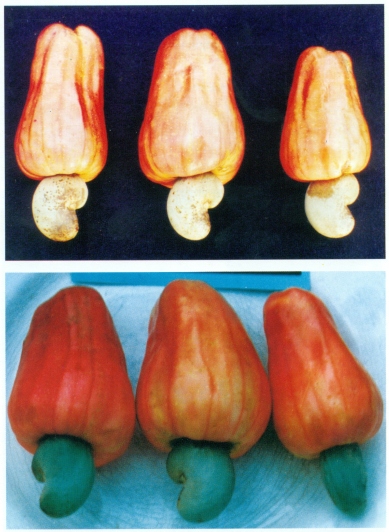
Vengurla-4 is a high-performing hybrid cashew variety developed by the Regional Cashew Nut Research Station, Vengurla, and released in 1981. Bred from the cross Midnapur Red × Vetore-56, it is known for its open canopy and extensive branching, promoting healthy tree architecture and fruit development. This variety is notable for its cluster-bearing habit, high flower sex ratio, and overall excellence across desirable traits. It flowers from November to December and fruits between February and May, offering a prolonged harvest window. Vengurla-4 produces red apples with a juice content of 76%, and yields W210 export-grade nuts with an average nut weight of 7.7 g, kernel weight of 1.91 g, and a shelling percentage of 31%. With a mean yield of 17.2 kg per tree, it is well-suited for commercial plantations. Planting materials are available at the Regional Fruit Research Station, Vengurla, Department of Horticulture, KKV Dapoli, and Government-approved nurseries.
Vridhachalam-3 (M 26/2)
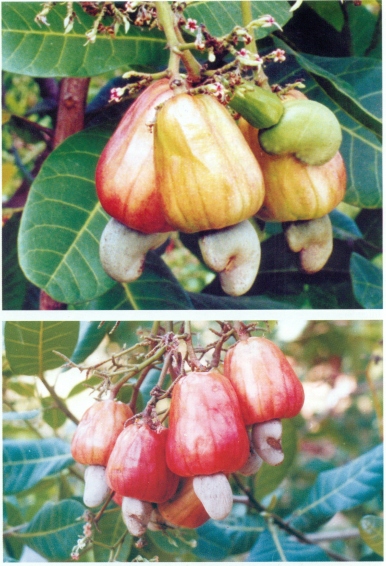
Vridhachalam-3 (M 26/2) is a high-quality selection variety developed from Edayanchavadi material and released in 1991 by the Regional Research Station, Vridhachalam, under Tamil Nadu Agricultural University. This variety is characterized by a compact canopy and intensive branching, supporting efficient space utilization and management. It is an early flowering type, initiating blooms in January–February and fruiting from February to May. Vridhachalam-3 is especially valued for its bold nuts and attractive red apples with a juice content of 72.8%. The nuts, classified under W210 export grade, weigh an average of 7.18 g, have a kernel weight of 2.16 g, and a shelling percentage of 29.1%. The variety gives a mean nut yield of 11.68 kg per tree and is recommended for growers seeking early harvest and good market-grade produce. Planting material is available from the Regional Research Station, TNAU, Vridhachalam.
Vridhachalam-4 (M 26/2)

Vridhachalam-4, released in 2000 by the Regional Research Station, Vridhachalam, under Tamil Nadu Agricultural University, is a promising selection variety developed from Vazhisodanipalayam material. It features a compact canopy and is categorized as a mid-season flowering type, although detailed data on its fruiting duration, apple characteristics, and kernel weight remain limited. The nuts fall under the W240 export grade, with an average nut weight of 6.63 g and a shelling percentage of 28.5%. What makes this variety remarkable is its exceptional productivity, with a mean nut yield of 3350 kg per hectare under rain-fed conditions, making it highly suitable for large-scale cultivation in non-irrigated regions. Planting materials are available at the Regional Research Station, TNAU, Vridhachalam.
VRI(Cw) H1
 H1.png)
VRI (Cw) H1 is a hybrid cashew variety released in 2009 by the Regional Research Station, Vridhachalam, under Tamil Nadu Agricultural University. Though specific details on flowering, fruiting, and canopy architecture are limited, this variety is known for producing attractive pinkish-red apples and high-quality W210 grade nuts with an average nut weight of 7.2 g and a shelling percentage of 30%. It is especially suitable for rain-fed cultivation, delivering an impressive mean yield of 2900 kg per hectare. This makes VRI (Cw) H1 a viable choice for growers in dryland regions seeking dependable yields and export-quality produce. Planting materials are available at the Regional Research Station, TNAU, Vridhachalam.
K-22-1
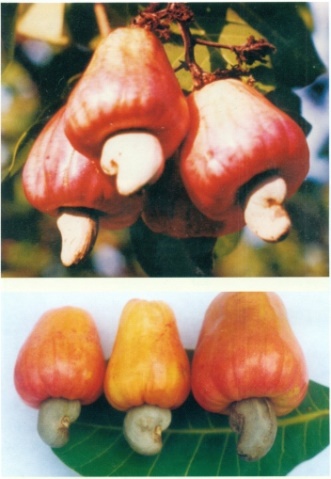
K-22-1 is a widely adopted selection variety of cashew, released in 1987 by the Cashew Research Station, KAU, Madakkathara, Kerala. Originating from Tree No. 16 of Bapatla (Kottarakkara 22), this variety is known for its compact canopy and intensive branching, which favors dense planting and efficient orchard management. It follows a mid-season flowering schedule, blooming from December to February and fruiting during February to March. The variety produces vibrant red apples with a juice content of 67.5%, and W280 grade nuts that weigh around 6.2 g, with a kernel weight of 1.6 g and a shelling percentage of 26.5%. With a mean nut yield of 13.2 kg per tree, K-22-1 remains a reliable and consistent performer in Kerala’s cashew sector. Planting material is available at both the Madakkathara and Anakkayam Cashew Research Stations under Kerala Agricultural University.
KAU Nihara

KAU NIHARA is a unique dwarf and compact cashew variety released in 2019 by the Cashew Research Station (CRS), Kerala Agricultural University, Madakkathara. It is a selection from a local collection in Thaliparamba, Kannur, and holds the distinction of being India’s first officially released dwarf cashew variety. Specifically bred for urban and peri-urban households, NIHARA is ideal for home gardens, rooftop cultivation, and small-scale farming systems due to its manageable canopy structure. Despite its compact growth habit, it delivers a commendable yield of 1.25 tonnes per hectare, making it a valuable addition to both home-based and intensive farming systems.
POORNIMA
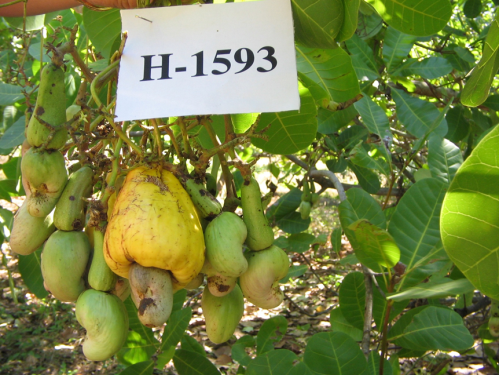
Poornima is a hybrid cashew variety released in 2006, developed from the cross BLA 139-1 × K-30-1. It features a compact canopy and intensive branching, making it well-suited for dense planting and organized orchard management. The variety flowers during the December–January period and produces attractive yellow apples. Nuts are of W210 export grade, with an average nut weight of 7.8 g, kernel weight of 2.6 g, and a shelling percentage of 31.0%. With a mean annual nut yield of 14.1 kg per tree, Poornima is a reliable and productive choice for commercial cashew cultivation.
Raghav
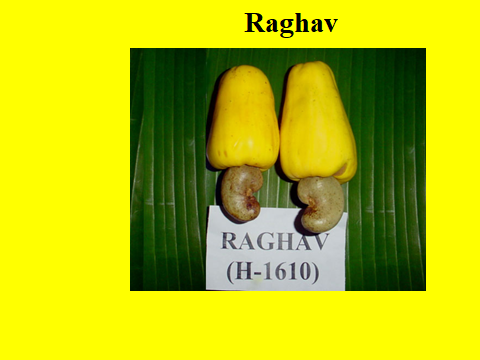
Raghav is a hybrid cashew variety released in 2002, recognized for its bold nuts and consistent performance. With a compact canopy, it is well-suited for systematic plantation practices. The variety flowers in the middle of January and is known to produce golden yellow apples. Each bunch typically bears about 7 fruits. The nuts are of W210 export grade, weighing an average of 9.2 g, with a kernel weight of 2.27 g. With a mean nut yield of 14.65 kg per tree, Raghav is considered a highly productive variety for commercial cashew farming.
Damodar

Released in 2002, Damodar is a hybrid cashew variety known for its comparative tolerance to tea mosquito, a significant pest in cashew plantations. It features a medium canopy type, making it adaptable to various planting densities. The variety flowers from December to January and produces attractive bright red apples. Each bunch typically bears around 6 fruits. The nuts fall under the W240 export grade, with an average nut weight of 8.2 g and kernel weight of 2 g. With a mean nut yield of 13.65 kg per tree, Damodar offers a reliable option for cultivators looking for pest-tolerant and high-quality nut varieties.
SREE
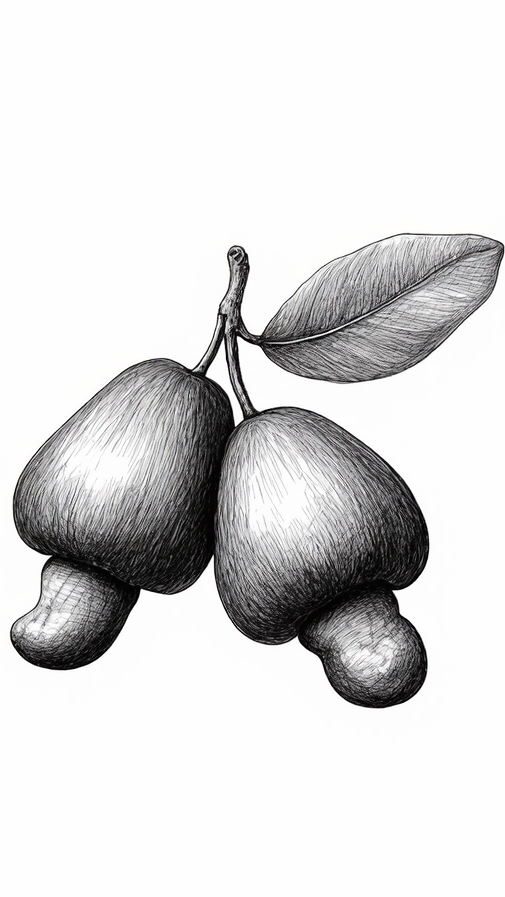
Sree is a high-yielding cashew variety released in 2019 by the Cashew Research Station, Kerala Agricultural University, Madakkathara. Specifically developed for the agro-climatic conditions of Kerala, Sree is an early-season variety that begins its flowering and fruiting cycle earlier than many traditional cultivars, allowing farmers to benefit from early market returns. It is particularly noted for its tolerance to tea mosquito bug, a major pest affecting cashew productivity. With an impressive average nut yield of 23.78 kg per tree, Sree is a reliable and profitable option for commercial cashew cultivation across the state. Its release marks a significant advancement in pest-resistant and region-specific cashew development.
Mridula (PTR1)

Mridula (PTR1) is a selection variety identified from the Pattannur region in Kannur district, Kerala. It is a late-season variety known for its distinctive feature—absence of cashew nut shell liquid (CNSL), making it ideal for specific processing needs. However, the variety bears very small nuts with an average weight of 3.55 g and a kernel weight of only 1.38 g. The annual nut yield is low at 3.31 kg per tree, making it unsuitable for commercial cultivation. The variety produces attractive, round, dark red apples, which may be of interest for household or research purposes rather than large-scale farming.

